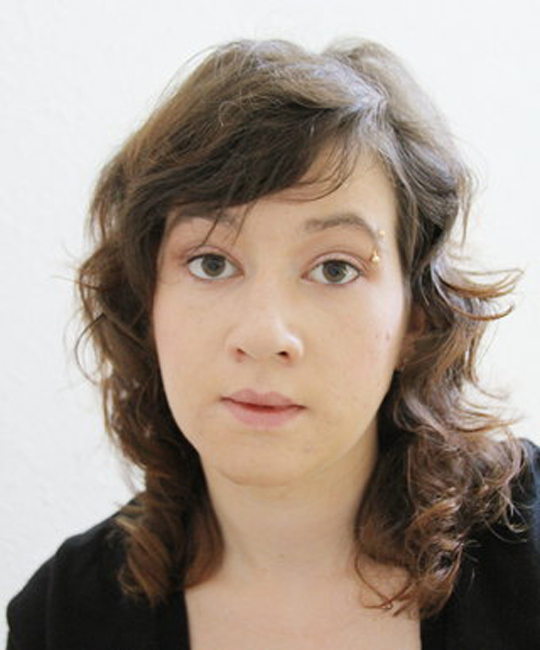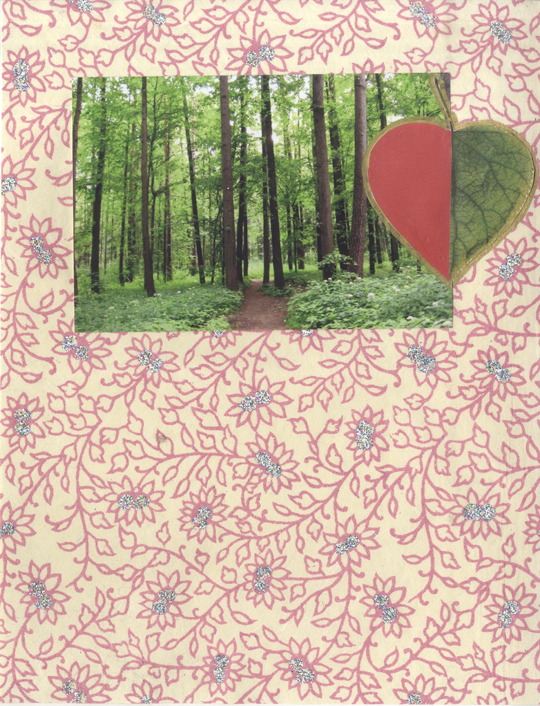Anya Kurennaya is a graduate of the MA Fashion Studies program at Parsons The New School for Design, having previously studied linguistics and foreign languages at the University of New Mexico in Albuquerque and at McGill University in Montreal. She currently serves as adjunct faculty in the Art and Design History and Theory department at Parsons. She has taught courses on fashion and music, the makeover and design culture, and critical reading and writing. This semester she is teaching two new independently developed courses, one about social, cultural, and historical perspectives on hair, and the other examining hip hop culture and style (which she will also be offering in Spring 2014). She is developing an upcoming graduate seminar on fashion writing. Anya is currently working to publish selections from her thesis, entitled “Look What the Cat Dragged In: Masculinity, Sexuality and Authenticity in 1980s Glam Metal.”
What current projects are you at work on or have you just completed?
Right now I’m working on a few projects simultaneously, in and out of the context of school. I spoke last month on a punk and fashion panel at the CBGB Festival, and I’m also working on a paper that I’m presenting at the Mid-Atlantic Popular and American Culture Association’s annual conference this weekend about the rapper A$AP Rocky’s affinity for luxury and avant-garde fashion. I’m writing it in collaboration with a close friend of mine who is a doctoral candidate in Music Theory at Columbia. We analyze his dress, music, and movement and posit that, in a similar vein to the work of artist Kehinde Wiley, A$AP Rocky represents the reframing of popular representations of hip hop masculinity, with avant-garde fashion aesthetics as the primary tool of subversion. I will also be presenting something similar next March at the Popular Culture Association/American Culture Association’s National Conference in Chicago.
Also, and this is a pet project of mine, I’m working on a zine with another close friend. It will be our third issue together and it will be a holiday present for our friends and families. Most of the imagery and writing in the zine come from our random collections of imagery and found objects, and we include inside jokes along with popular references so that it’s at once very personal and very universal. The first issue was called “Listen to Your Heart” and the second was called “Say Yes to the Bread” – the third is as yet untitled since we have a lot to live up to in terms of naming. In addition to all this, I hold down a job at a retailer where I do visual merchandising and window display.
 Cover page of “Say Yes to the Bread”
Cover page of “Say Yes to the Bread”
What inspired these projects?
Luckily my merchandising/display job is in a very rich and beautiful environment, so I’m inspired every day just being there. And I can’t take any credit for the punk and fashion panel – that was an invitation I was very lucky to receive. The inspiration for the A$AP Rocky research came mostly from conversations with the students in my Music as Fashion course, along with my experiences at hip hop shows and conversations with my friends. My students excel at keying in on fashion as the starting point for conversations about musicians, so when I showed them images of A$AP Rocky, a rapper whose style I find interesting, they had plenty to say about what his style might possibly represent. Those discussions, which have continued and deepened in my Hip Hop Culture and Style course, crystallized into a more solid idea about representations of luxury in hip hop. I combined these thoughts with my own research on fashion and gender to what has now turned into a very intriguing and multilayered take on the subject.
The zine started as an escape from academic pressures – my friend and I wanted to create a space where we could express ourselves artistically without judgment, both from outsiders and from ourselves. We would get together and bring magazines we had laying around and just cut them up and play around. We both incorporate lots of visual analysis in our lectures, so it was a fun experiment to analyze imagery by actively manipulating it rather than formally assessing imagery on a computer screen when writing about it or on a projection when lecturing about it – the process feels more active and connected. It’s become a very important, almost therapeutic, process for the both of us, and it is always incredibly fun.
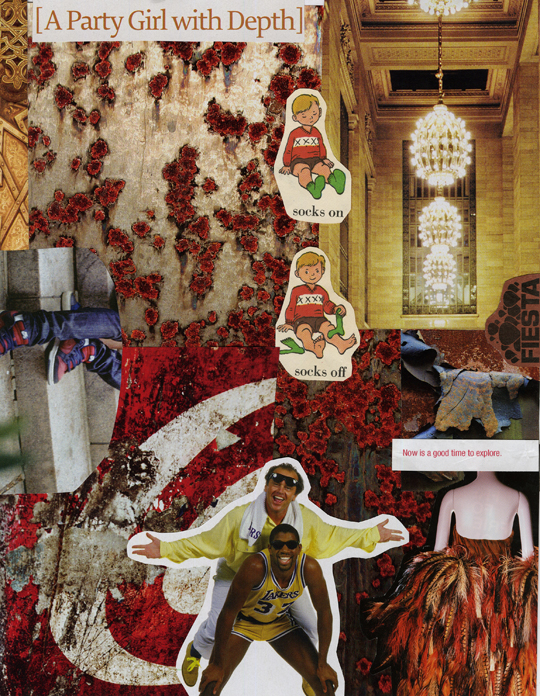 Page from Say Yes to the Bread – “A Party Girl with Depth”
Page from Say Yes to the Bread – “A Party Girl with Depth”
Are you finding connections between these pursuits, or do they feel separate?
Absolutely. I’m fascinated by connections in general, whether I actively seek them or whether they make themselves plainly evident. Even with these widely differing pursuits, the connections are vast. In every project I’m involved in, there is an aspect of the project that involves critically evaluating visual imagery and an aspect that involves producing that kind of imagery with critical intention. On a more specific level, my personal interests carry over from one project to another. I am incredibly lucky to teach on topics that I absolutely adore, so it’s no surprise that that content finds its way into other aspects of my life. A lot of the zine content has to do with hip hop since I explore it in my classes and research. At the same time, the playful approach to zine-making has really changed my academic research process. It has become much more experimental and open-minded, and I have a much easier time finding connections between starkly different images or scholarly ideas.
Do you find connections between these projects and your current, future, or recent work for Parsons?
Again, absolutely. I am in a very lucky position to be teaching elective courses about subjects I have extreme personal passion for—fashion and music, hip hop culture, hair and beauty culture, and the way popular culture represents—or fails to truly represent—the complexities of race, class, and gender. All this is an extension and continuation of the research I undertook while a master’s student in Fashion Studies within Parsons’ School of Art and Design History and Theory. The CBGB panel was a very exciting opportunity to take fashion theory outside of the classroom and bring it to a public forum; lots of us have these thoughts circulating through our minds but fashion studies synthesizes these thoughts and places them in a particular context. For example, when the conversation turned to punk and issues of class and status, I was able to offer ideas advanced by Dick Hebdige, a leading cultural studies theorist, who explored class in subculture extensively.
The zine, too, has ended up being more informed by my work for Parsons than I thought it would be. First of all, my respect for my students has increased tenfold since embarking on a creative project on my own. They are very comfortable with hands-on visual research and, coming from a very academic perspective, it’s still very much a learning process for me. But I’m always including course content in some way or another. I’ll analyze an image in class and then some iteration of it will end up somewhere in the zine. Or vice versa – I’ll find an image to incorporate into that and then it will creep into the lecture as the perfect illustration for a concept. It’s all cultural anthropology, whether it takes place in a class discussion or whether it’s more hands-on.
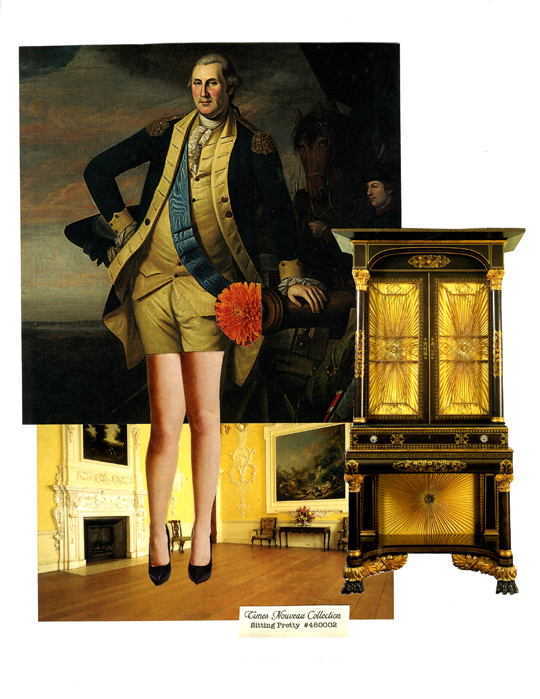 Page from Say Yes to the Bread – from the spread entitled “Men Ladies”
Page from Say Yes to the Bread – from the spread entitled “Men Ladies”
How have New York’s resources contributed to your current work?
From the point of view of examining fashion, particularly the everyday lived experience of dress, there is no better place to be. One of my hip hop class sessions is devoted to sneakers, and just from walking and riding the subway between Parsons and Harlem, I probably see over 300 sneakers a day. I’ve had conversations with strangers about their sneakers, or they’ve approached me to talk about mine. If you pay attention to what’s around you, you start to notice micro-trends developing: the way certain shoes are laced, the way straps are left to hang off the shoe, the way daily wear and tear is proudly displayed or carefully managed, and so on. Sometimes the abundance of visuals can become overwhelming, but usually it’s inspiring to see so much on a daily basis. There is always a show or a lecture or a museum exhibition or an event, but sometimes just walking down the street is an inspirational event in and of itself. I usually carry a notebook with me when commuting, and I’ve had some of my best ideas on the downtown 2 train.
Is this your first project of this kind? What unique challenges and discoveries are presenting themselves?
The panel discussion was the first I’ve ever participated in, and while I was anxious at first, it became much easier when I saw how applicable my research was to the topic. I consider myself less well-read about punk as compared to other genres, but as soon as the conversation turned to the differences between punk and glam styles I was so relieved—I wrote my master’s thesis about the way glam metal musicians negotiate gender and sexuality through dress. I was able to bring some of these ideas to the discussion and apply them productively to punk as well!
The A$AP Rocky paper is my first time writing academically about hip hop, and it is proving to be a challenge only because there is so much to consider—we are simultaneously looking at dress, music, and movement and finding it a struggle to keep it manageable for ourselves. And as always, the biggest challenge is finding the time and energy for all these projects, but the fact that I have passion for all of them keeps me motivated.
If this project is part of a long-term interest, how have you seen your work shift through time?
Even though the topics I’m examining are different now than before, I think I’ve had a lifelong interest in popular culture. As a child I would watch countless hours of VH1 and TVLand, watching older shows and nostalgic recaps aimed at a much older audience. I told people I wanted to be a popular culture historian after I saw some talking head on some nostalgic clip show bearing that title. Why a seven year old wanted to do that, I don’t know, but I’m glad things turned out this way. When I think about it now, in my lectures I do sort of take on the role of a popular culture historian, or perhaps pop culture ethnographer is the better term.
If you are at the culmination of a project, do you have plans for your next endeavors? What should we look out for from you in the future?
More zines! And more research on the interrelated nature of fashion, music, and design; I’m scheduled to present at a few conferences next year, on glam metal and on hip hop fashion. I’m also starting to dig back to my academic roots – I studied linguistics and foreign languages in college, so I am thinking a lot these days about the way language and fashion relate to one another. Particularly in a music video, for example, the lyrics relate strongly to the musical structure and also the aesthetic structure of the video. I’m also interested in celebrity culture these days, particularly celebrity gossip – I would love to examine tabloids from an academic perspective, looking at our fascination with star culture and the way the mundane everyday details of star lives are made spectacular.
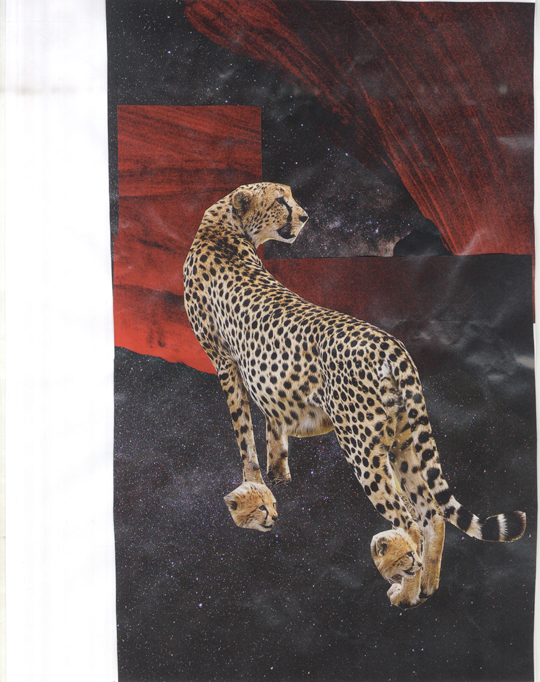 Page from Listen to Your Heart
Page from Listen to Your Heart
Upcoming Conferences
Mid-Atlantic Popular & American Culture Association Annual Conference – November 7-9, 2013 in Atlantic City, NJ – (mapaca.net) – “Call me Basquiat Picasso”: A$AP Rocky’s Self-Fashioning and the Historical Repositioning of Black Masculinity
Popular Culture Association/American Culture Association National Conference – 16-19 April 2014 in Chicago (http://pcaaca.org/) – “What’s That Jacket, Margiela”: Luxury and Avant Garde Fashion in Hip Hop
Southwest Popular/American Culture Association Conference – February 19-22, 2014 in Albuquerque, New Mexico (http://southwestpca.org/) – Cocked and Loaded: Glam Metal Masculinity and the Sartorial Negotiation of the Female Threat


























